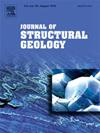埃迪卡拉-寒武系前陆褶皱冲断带的压力-温度-时间变形:Araçuaí造山带南埃斯帕纳帕拉索前缘
IF 2.9
2区 地球科学
Q2 GEOSCIENCES, MULTIDISCIPLINARY
引用次数: 0
摘要
为了重建前陆褶皱冲断带的构造演化,采用了野外构造观测、应变定量、石英晶体结构、流体包裹体和伊利石结晶度(IC)分析以及白云母细粒白云母原位Rb-Sr定年和K-Ar定年等多种方法。研究区包括巴西Serra do Cipó的south espinhao Front,标志着本文章由计算机程序翻译,如有差异,请以英文原文为准。
Pressure-temperature-time deformation of an Ediacaran-Cambrian foreland fold-and-thrust belt: the Southern Espinhaço Front, Araçuaí Orogen
To reconstruct the tectonic evolution of a foreland fold-and-thrust belt, a multi-method approach was carried out involving field-based structural observations, strain quantification, analyses of quartz crystallographic textures, fluid inclusions and illite crystallinity (IC), and in situ muscovite Rb-Sr dating and K-Ar dating of fine fractions of white mica. The studied area encompasses the Southern Espinhaço Front in Serra do Cipó, Brazil, marking the boundary between the Foreland Domain (FLD) of the São Francisco Craton (west) and the Fold-and-Thrust Domain (FTD) of the Araçuaí-West Congo Orogen (east). In this area, the Mesoproterozoic Espinhaço Supergroup was thrust over the Ediacaran-Cambrian Bambuí Group during the Brasiliano-Pan-African orogeny. All structural features indicate west-verging tectonics, with oblate strain ellipsoids, suggesting flattening strain and volume loss. Quartz crystallographic textures indicate primarily rhomb <a> dislocation glide for the larger granulometric fractions (>100 μm), with finer grains experiencing dissolution-precipitation creep. Primary, aqueous fluid inclusions hosted in syn-tectonic veins indicate local intra-basinal fluid circulation. Deformation conditions ranges were 300–410 °C and 1.7–6.0 kbar in the FLD, and 385–450 °C and 2.8–8.0 kbar in the FTD. Rb-Sr muscovite dating suggests a metamorphic peak at 549 ± 17 Ma. K-Ar ages for <2 μm mica were 510–496 Ma in the FLD and 476–456 Ma in the FTD, and <0.2 μm mica dated at 432.6 ± 7.5 Ma. These results indicate progressive crustal wedge thickening under a critical taper model, driving deformation and basal detachment propagation into the foreland accompanied by exhumation.
求助全文
通过发布文献求助,成功后即可免费获取论文全文。
去求助
来源期刊

Journal of Structural Geology
地学-地球科学综合
CiteScore
6.00
自引率
19.40%
发文量
192
审稿时长
15.7 weeks
期刊介绍:
The Journal of Structural Geology publishes process-oriented investigations about structural geology using appropriate combinations of analog and digital field data, seismic reflection data, satellite-derived data, geometric analysis, kinematic analysis, laboratory experiments, computer visualizations, and analogue or numerical modelling on all scales. Contributions are encouraged to draw perspectives from rheology, rock mechanics, geophysics,metamorphism, sedimentology, petroleum geology, economic geology, geodynamics, planetary geology, tectonics and neotectonics to provide a more powerful understanding of deformation processes and systems. Given the visual nature of the discipline, supplementary materials that portray the data and analysis in 3-D or quasi 3-D manners, including the use of videos, and/or graphical abstracts can significantly strengthen the impact of contributions.
 求助内容:
求助内容: 应助结果提醒方式:
应助结果提醒方式:


